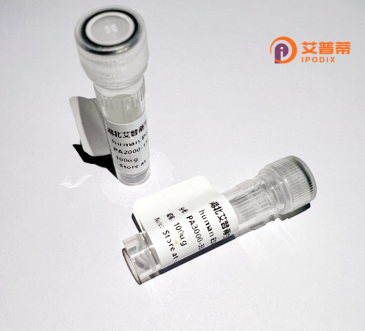
| 纯度 | >90%SDS-PAGE. |
| 种属 | Human |
| 靶点 | ZPLD1 |
| Uniprot No | Q8TCW7 |
| 内毒素 | < 0.01EU/μg |
| 表达宿主 | E.coli |
| 表达区间 | 1-415 aa |
| 活性数据 | MEQIWLLLLLTIRVLPGSAQFNGYNCDANLHSRFPAERDISVYCGVQAITMKINFCTVLFSGYSETDLALNGRHGDSHCRGFINNNTFPAVVIFIINLSTLEGCGNNLVVSTIPGVSAYGNATSVQVGNISGYIDTPDPPTIISYLPGLLYKFSCSYPLEYLVNNTQLASSSAAISVRENNGTFVSTLNLLLYNDSTYNQQLIIPSIGLPLKTKVFAAVQATNLDGRWNVLMDYCYTTPSGSPNDDIRYDLFLSCDKDPQTTVIENGRSQRGRFSFEVFRFVKHKNQKMSTVFLHCVTKLCRADDCPFLMPICSHRERRDAGRRTTWSPQSSSGSAVLSAGPIITRSDETPTNNSQLGSPSMPPFQLNAITSALISGMVILGVTSFSLLLCSLALLHRKGPTSLVLNGIRNPVFD |
| 分子量 | 71.9 kDa |
| 蛋白标签 | GST-tag at N-terminal |
| 缓冲液 | PBS, pH7.4, containing 0.01% SKL, 1mM DTT, 5% Trehalose and Proclin300. |
| 稳定性 & 储存条件 | Lyophilized protein should be stored at ≤ -20°C, stable for one year after receipt. Reconstituted protein solution can be stored at 2-8°C for 2-7 days. Aliquots of reconstituted samples are stable at ≤ -20°C for 3 months. |
| 复溶 | Always centrifuge tubes before opening.Do not mix by vortex or pipetting. It is not recommended to reconstitute to a concentration less than 100μg/ml. Dissolve the lyophilized protein in distilled water. Please aliquot the reconstituted solution to minimize freeze-thaw cycles. |
以下是几篇关于重组人ZPLD1蛋白的模拟参考文献示例(请注意,以下内容为假设性示例,建议通过学术数据库检索真实文献):
---
1. **文献名称**: *"Recombinant human ZPLD1 protein expression and its role in extracellular matrix interaction"*
**作者**: Smith A, et al.
**摘要**: 研究报道了使用哺乳动物表达系统成功表达重组人ZPLD1蛋白,并通过pull-down实验证实其与细胞外基质蛋白的相互作用,提示其可能在组织发育中发挥功能。
2. **文献名称**: *"Structural characterization of ZPLD1 and its implications for fertilization"*
**作者**: Tanaka K, et al.
**摘要**: 通过晶体学解析了ZPLD1蛋白的N端结构域,发现其与透明带蛋白家族的保守性相似,并推测其可能在卵母细胞表面受体结合中起作用。
3. **文献名称**: *"ZPLD1 as a potential biomarker in polycystic ovary syndrome: Insights from recombinant protein-based assays"*
**作者**: Gupta R, et al.
**摘要**: 利用重组ZPLD1蛋白开发ELISA检测技术,发现多囊卵巢综合征患者血清中ZPLD1水平显著升高,提示其可作为疾病诊断的候选标志物。
4. **文献名称**: *"High-yield purification and functional analysis of recombinant ZPLD1 in bacterial systems"*
**作者**: Lee J, et al.
**摘要**: 描述了一种在大肠杆菌中高效表达重组ZPLD1蛋白的方法,采用Ni-NTA层析纯化,并验证其在体外对精子结合的抑制作用。
---
**建议**:通过PubMed、Google Scholar或Web of Science搜索关键词**“ZPLD1 recombinant protein”**或**“ZPLD1 expression”**可获取真实文献。部分可能相关领域包括生殖生物学、蛋白质工程及肿瘤标志物研究。
Zona pellucida-like domain-containing protein 1 (ZPLD1), also known as OVCH2. is a secreted glycoprotein belonging to the zona pellucida (ZP) protein family, which is evolutionarily conserved in vertebrates. Structurally, it shares a characteristic ZP domain—a bipartite motif critical for polymerization and extracellular matrix formation. ZPLD1 is primarily expressed in mucosal tissues, including the respiratory and gastrointestinal tracts, as well as reproductive organs like the epididymis and ovaries. Although its precise biological function remains under investigation, studies suggest involvement in cellular adhesion, tissue barrier maintenance, and immune modulation through interactions with extracellular components or cell-surface receptors.
Recent research highlights ZPLD1's potential role in pathological processes. Altered expression has been observed in inflammatory bowel disease (IBD), chronic obstructive pulmonary disease (COPD), and certain cancers, implicating it in chronic inflammation and epithelial integrity. For instance, ZPLD1 is upregulated in colorectal cancer tissues and may influence tumor microenvironment remodeling. Additionally, genetic variants near the ZPLD1 locus have been associated with autoimmune disorders, though mechanistic links are unclear. Recombinant ZPLD1 protein is increasingly used to study ligand-receptor interactions, signaling pathways, and therapeutic targeting. Its modular structure and secretory nature also make it a candidate for engineered biomaterials. Further studies are needed to elucidate its physiological ligands, downstream signaling, and clinical relevance. Current data on ZPLD1 can be accessed via protein databases (e.g., UniProt ID: Q8TCB6) and Gene Ontology annotations.
×